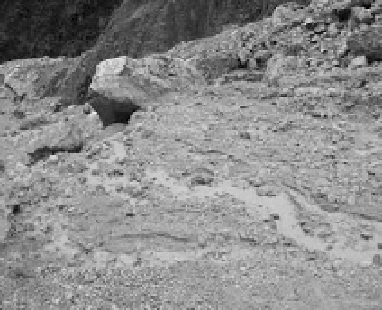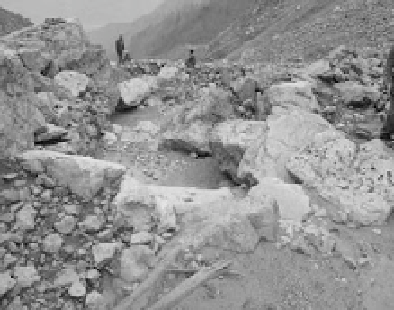Environmental Engineering Reference
In-Depth Information
An empirical formula was proposed for the dissipation ratio (Lu et al., 2006)
§
h
h
·
K
0.97 exp
4.08
k
u
100%
(11.36)
¨
¸
sp
©
¹
t
in which
h
k
is the critical flow depth, and
h
t
is the total height of the stepped spillway or the sum of
heights of the all steps of the spillway. For the case of the step-pool system,
h
k
/
h
t
was the ratio of the
critical flow depth to the height of the steps, which was estimated at around 0.25. Then, the energy
dissipation ratio on the steps was about 0.35.
The total energy dissipation ratio at step-pools
s
K is given by:
1 1
K
K
1
K
)
(11.37)
sp
hj
st
The total energy dissipation ratio at step-pools was calculated at 62.3%. Because the flow energy also
consumed at boundary friction it may be deduced that less than one third of the flow energy could be
used to carry solid particles. In other words at least three times high flow discharge was needed for
initiation of debris flows after a step-pool system was constructed. In Wenjiagou, almost all rainfalls with
intensity higher than 30 mm/day triggered debris flows in 2008. The step-pool system stabilized new
Wenjiagou in 2009, and only a small debris flow with a volume of 0.02 million m
3
was triggered by a
rainfall of intensity of 91.2 mm/day on July 17. It seems that the critical rainfall intensity for triggering
debris flows was enhanced by 3 times by the step-pool system, which coincidently agreed with the
conclusion from the energy dissipation ratio by step-pools.
Because the flow energy was dissipated by the step-pool system almost no bed incision occurred in
2009. Debris flows and sediment laden flows carried sediment from the upstream reaches unload the
sediment in the step-pool section because the flow energy was not enough to carry the sediment further
downstream. Thus, debris flows reduced to normal torrential floods with no any catastrophe. The pools
were filled with the sediment. Nevertheless, low sediment load flows and clear water flows during the
receding part of floods scoured fine sediment from the pools and partly recover the pools, as shown in
Fig.11.66.
Fig. 11.66
Pool filled with sediment by the debris flows from upstream and partly recovered during low sediment
load and clear water flows
Five rainstorms with rainfall intensity higher than 30 mm/day occurred in 2009, which were recorded
by a rainfall meter in Wenjiagou. The step-pool system was partly damaged after each rainstorm. The
research team repaired the damaged steps after the rainstorms. Only a small debris flow, with a volume
of only 0.02 million m
3
, occurred on July 17, 2009 triggered by a rainfall intensity of 91.2 mm/day. The
small debris flow occurred at the downstream reach of the step-pools and caused no consequences.




Search WWH ::

Custom Search